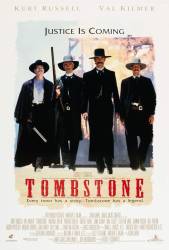Visible crew/equipment: When Virgil goes outside on the night of the storm after seeing Wyatt and Morgan, the arm of a crane is visible in the background behind the roof of a building. It sticks vertically up in the air, probably for mounting lights.

Tombstone (1993)
1 visible crew/equipment mistake
Directed by: George P. Cosmatos
Starring: Kurt Russell, Val Kilmer, Bill Paxton, Charlton Heston, Sam Elliott, Michael Biehn, Powers Boothe, Dana Delany, Jason Priestley
Revealing mistake: When Wyatt Earp and the actress, whom he marries later in the movie, meet on horseback, they go on a fast paced ride that concludes after going down a steep hill. If you look at the actress' feet, you will see she is riding side-saddle - a very difficult feat considering the riding they do. If you look closely you can see her real leg, safely on the other side of the horse. The side-saddle leg must be fake.
Johnny Tyler: Is something on your mind?
Wyatt Earp: Just want to let you know you're sittin' in my chair.
Johnny Tyler: Is that a fact?
Wyatt Earp: Yeah, it's a fact.
Johnny Tyler: Well, for a man who don't go heeled you run your mouth kind of reckless, don't you?
Wyatt Earp: No need to go heeled to get the bulge on a tub like you.
Johnny Tyler: Is that a fact?
Wyatt Earp: Mm-hmm. That's a fact.
[Johnny Tyler stands up.]
Johnny Tyler: Well, I'm real scared.
Wyatt Earp: Damn right, you're scared. I can see that in your eyes.
[Wyatt walks up to Johnny as Johnny reaches for his gun.]
Johnny Tyler: All right now.
Wyatt Earp: Go ahead. Go ahead, skin it. Skin that smoke wagon and see what happens.
Johnny Tyler: Listen, mister, I-I'm gettin' awful tired of your-
[Wyatt slaps Johnny hard in the face.]
Wyatt Earp: I'm gettin' awful tired of your gas. Now jerk that pistol and go to work.
[Johnny doesn't do anything and Wyatt slaps him in the face again.]
Wyatt Earp: I said throw down, boy.
[Wyatt slaps Johnny harder and when Johnny turns to look at Wyatt his mouth is bleeding.]
Wyatt Earp: You gonna do somethin' or just stand there and bleed?
[Johnny still doesn't do anything.]
Wyatt Earp: No? I didn't think so.
Trivia: Val Kilmer has been quoted as saying that screenwriter Kevin Jarre insisted the actors wear real wool costumes, in accordance with the time period. During the scene in the Birdcage Theater, Val Kilmer says, a thermometer was placed on the set, and it read 134 degrees Fahrenheit. Kilmer suggested jokingly that this was the reason Doc Holliday killed so many people: "It's just, like, he wore wool in the summer, in the Arizona territory, and that made him mad."
Question: What did Doc mean when he said "It's not revenge he's after. It's the reckoning"?
Answer: I've spent a lot of time thinking about this very question, and here's what I've come up with. I think there are at least two differences between revenge and a reckoning. First, I think it has to do with the scale of the response to an offending action. Revenge, in my mind, is an eye for an eye, i.e, "You killed my brother and wounded another, so I will inflict the same action on your family (or group, gang, whatever). " A reckoning is less a measured response to an offending action and more of a full-scale punishment, i.e, "You killed my brother and wounded another, so I will now slaughter your entire family-including those who were not directly responsible for the offending action." Second, I think there is also a difference in motivation. Revenge tends to be a very personal response to something, whereas a reckoning tends to be more of a response fueled by a need for justice. In Wyatt's case, it was both. He was enraged by what happened to his family, but was also a lawman.
Thank you for this response! I've only seen Tombstone a million times and asked the same question every time. It's hard to separate the difference between the two but I believe you nailed it. Well done.
I'm thinking the opposite in terms. Revenge is "Reflexive" and is generally any means necessary (out of an abundance of pain or rage) to hurt the other party. "Revenge is a dish best served cold." If one is exacting justice there's no need to be cold hearted. Therefore, Reckoning is (to me) a fair balancing of the "scales" hence "an eye for an eye." Not only consequences of actions as it were but a corrective action to an incorrect circumstance. Just my understanding.
The problem with that theory is there is no difference in the end because the end result was the same...the killing. True reckoning could have only been achieved though the apprehension and punishment by trial and jury, anything other than that is simply revenge.





Chosen answer: A reckoning is like a judgment day, exacting retribution for one's actions. Doc was very well educated and had a very large vocabulary. He was correctly pointing out the subtle difference between revenge (to make Wyatt feel better about losing Morgan and about Virgil's crippling injury) and the fact that Wyatt was bringing about a judgment day (or reckoning) for each of the men who hurt his family.
MovieFan612